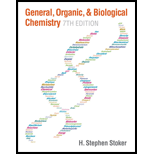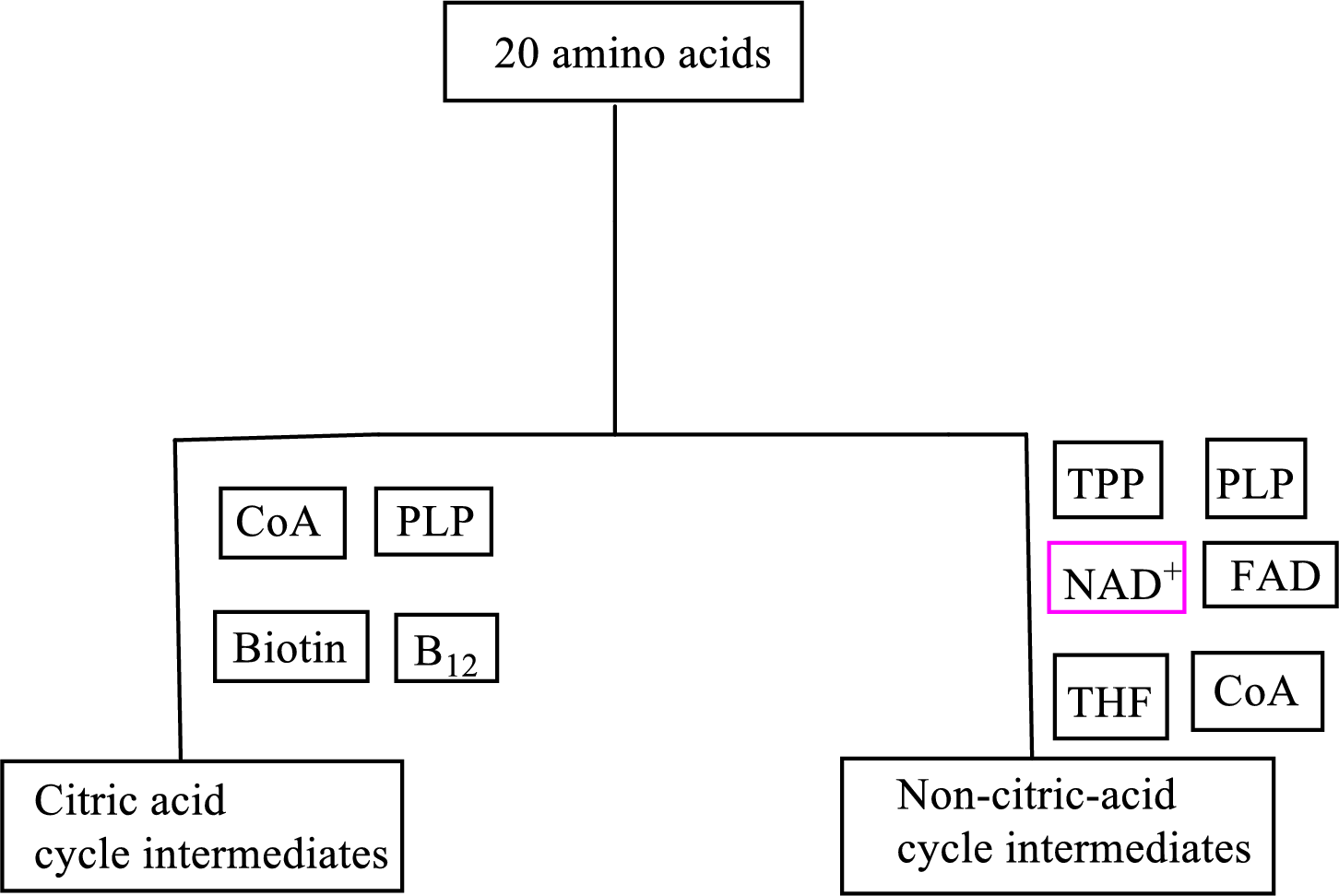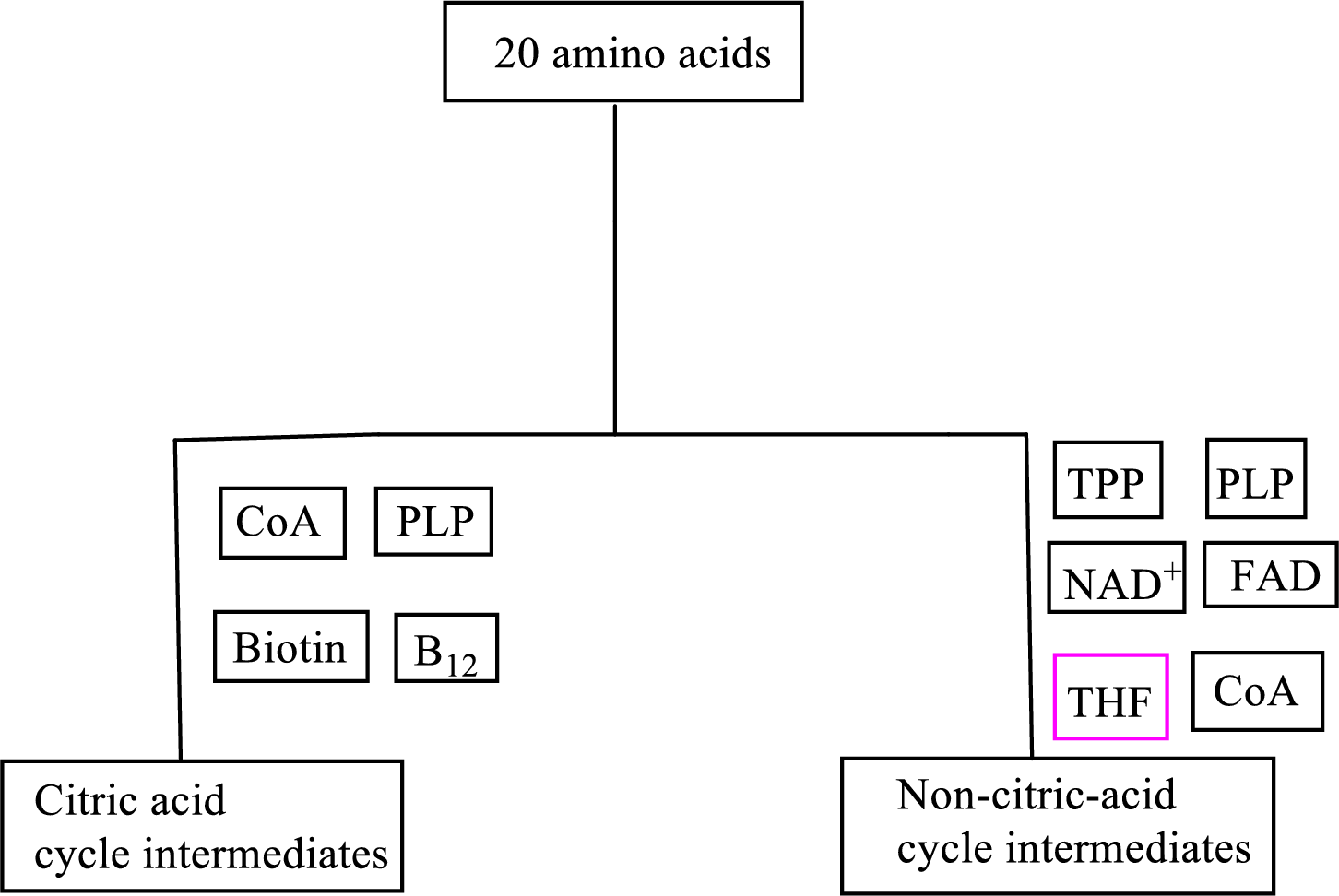
Concept explainers
(a)
Interpretation:
To indicate whether B vitamin niacin is involved as a cofactor in the processes of (1) transamination, (2) oxidative deamination, (3) urea cycle, (4) carbon skeleton degradation to CAC intermediates, or (5) carbon skeleton degradation to non-CAC intermediates.
Concept introduction:
Cofactors are non-protein organic compounds that are used along with the enzymes and help to carry forward the reaction. The coenzymes containing B-vitamin serve as temporary carriers of atoms or
Transamination reaction is a biochemical reaction that involves the transfer of an amino group. In transamination reaction exchange of an amino group from an
A biochemical reaction in which an
A urea cycle is a cyclic biochemical pathway that involves the production of urea using ammonium ions and aspartate molecules as nitrogen sources. The reactants in the formation of carbamoyl phosphate are ammonium ion, water, and carbon dioxide. The desired product of the urea cycle is urea.
There are 20 standard amino acids. Each amino acid has a different carbon skeleton and has a different degradation pathway for its carbon skeleton.
(a)
Answer to Problem 26.115EP
B vitamin niacin is involved as a cofactor in the process of oxidative deamination and in carbon skeleton degradation to non-CAC intermediates.
Explanation of Solution
Coenzyme nicotinamide adenine dinucleotide
Oxidative deamination reaction of glutamate requires dehydrogenase enzyme. It is an oxidoreductase enzyme and works with either
The oxidative deamination reaction of glutamate amino acid is as follows:

Nicotinamide adenine dinucleotide

(b)
Interpretation:
To indicate whether B vitamin folate is involved as a cofactor in the processes of (1) transamination, (2) oxidative deamination, (3) urea cycle, (4) carbon skeleton degradation to CAC intermediates, or (5) carbon skeleton degradation to non-CAC intermediates.
Concept introduction:
Cofactors are non-protein organic compounds that are used along with the enzymes and help to carry forward the reaction. The coenzymes containing B-vitamin serve as temporary carriers of atoms or functional groups in the redox and group transfer reactions associated with the metabolism of ingested food in order to obtain energy from the food.
Transamination reaction is a biochemical reaction that involves the transfer of an amino group. In transamination reaction exchange of an amino group from an
A biochemical reaction in which an
A urea cycle is a cyclic biochemical pathway that involves the production of urea using ammonium ions and aspartate molecules as nitrogen sources. The reactants in the formation of carbamoyl phosphate are ammonium ion, water, and carbon dioxide. The desired product of the urea cycle is urea.
There are 20 standard amino acids. Each amino acid has a different carbon skeleton and has a different degradation pathway for its carbon skeleton.
(b)
Answer to Problem 26.115EP
B vitamin folate is involved as a cofactor in carbon skeleton degradation to non-CAC intermediates.
Explanation of Solution
Coenzyme tetrahydrofolate

(c)
Interpretation:
To indicate whether B vitamin biotin is involved as a cofactor in the processes of (1) transamination, (2) oxidative deamination, (3) urea cycle, (4) carbon skeleton degradation to CAC intermediates, or (5) carbon skeleton degradation to non-CAC intermediates.
Concept introduction:
Cofactors are non-protein organic compounds that are used along with the enzymes and help to carry forward the reaction. The coenzymes containing B-vitamin serve as temporary carriers of atoms or functional groups in the redox and group transfer reactions associated with the metabolism of ingested food in order to obtain energy from the food.
Transamination reaction is a biochemical reaction that involves the transfer of an amino group. In transamination reaction exchange of an amino group from an
A biochemical reaction in which an
A urea cycle is a cyclic biochemical pathway that involves the production of urea using ammonium ions and aspartate molecules as nitrogen sources. The reactants in the formation of carbamoyl phosphate are ammonium ion, water, and carbon dioxide. The desired product of the urea cycle is urea.
There are 20 standard amino acids. Each amino acid has a different carbon skeleton and has a different degradation pathway for its carbon skeleton.
(c)
Answer to Problem 26.115EP
B vitamin biotin is involved as a cofactor in carbon skeleton degradation to CAC intermediates.
Explanation of Solution
Biotin is involved in the carbon skeleton degradation pathway to CAC intermediates. An overview of the B vitamin participations in the degradation pathways for the carbon skeletons of the 20 standard amino acids is as follows:

(d)
Interpretation:
To indicate whether B vitamin
Concept introduction:
Cofactors are non-protein organic compounds that are used along with the enzymes and help to carry forward the reaction. The coenzymes containing B-vitamin serve as temporary carriers of atoms or functional groups in the redox and group transfer reactions associated with the metabolism of ingested food in order to obtain energy from the food.
Transamination reaction is a biochemical reaction that involves the transfer of an amino group. In transamination reaction exchange of an amino group from an
A biochemical reaction in which an
A urea cycle is a cyclic biochemical pathway that involves the production of urea using ammonium ions and aspartate molecules as nitrogen sources. The reactants in the formation of carbamoyl phosphate are ammonium ion, water, and carbon dioxide. The desired product of the urea cycle is urea.
There are 20 standard amino acids. Each amino acid has a different carbon skeleton and has a different degradation pathway for its carbon skeleton.
(d)
Answer to Problem 26.115EP
Explanation of Solution
Coenzyme
Transamination reaction involves a simple transfer of amino groups but the overall reaction occurs in several steps and also requires
Coenzyme
An overview of the B vitamin participations in the degradation pathways for the carbon skeletons of the 20 standard amino acids is as follows:

Want to see more full solutions like this?
Chapter 26 Solutions
GENERAL,ORGANIC,+BIO.CHEM.-MINDTAP
- A patient presenting in musty odour and hypopigmentation has also presented with high levels of phenyl pyruvate in their blood. Which enzyme is upregulated? A. Phenylalanine dehydrogenase B. Phenylalanine hydroxylase C. Transaminase D. Arginasearrow_forward1. Explain the reaction mechanism involved how glucogenic amino acids can yield either a pyruvic acid or an oxaloacetic acid. In what pathway will pyruvic or oxaloacetic acid be used and why is this pathway important? 2. Discuss the reaction mechanism involved how the -NH2 groups of amino acids are being metabolized. 3. Explain why gluconeogenesis under conditions of starvation or diabetes breaks down body proteins. Complete answer please. Thank you. |arrow_forwardWhich one of the following statements is not correct for the transamination reaction that amino acid contributed? a.Pyridoxal phosphate has a crucial role in transamination reactions. b.Enzyme levels may be high in liver and muscle diseases. c.Transamination reactions are catalyzed by aminotransferases. d.Alanine aminotransferase catalyzed reactions can be given as an example for transamination reactions. e.Transamination reactions are irreversible.arrow_forward
- A. List all the materials required for beta-oxidation of fatty acids. How does this process differ from the Biosynthesis of fatty acids? B. Outline the pathway involved in the synthesis of cholesterol from six-carbon intermediate Mevalonate. C. Describe all the stages involved in the urea cycle (Transmination, Ammonia Transport, and stages of the urea cycle).arrow_forwardDefine the following terms: a. thiolytic cleavage b. ketogenesis c. ketone bodies d. α-oxidation e. ACCarrow_forward(a) What amino acid, other than alanine, can be converted by transaminationto a gluconeogenic precursor? (b) Calculate the cost, in ATP equivalents, of converting two molecules of this amino acid to one molecule of glucose.arrow_forward
- 26. Which of the following statements is correct? A. Insulin can activate pyruvate carboxylase B. More energy in the form of ATP is required to synthesize glucose from pyruvate than can be obtained from glucose by glycolysis alone C. Fructose-2,6-bisphosphate is a modulator that can stimulate either glycolysis or gluconeogenesis, depending on cellular glucose concentration D. All of the abovearrow_forwardExplain how the prolong intake of antacids can lead to vitamin B12 deficiency?arrow_forwardIndicate what will happen ( increase, decrease or no effect) tothe activity of the enzyme or rate of the metabolic pathway in the given conditions a. release of glucagon in the blood to the activity of carnitine acyl transferase 1 b. high malonyl CoA to the activity of carnitine acyl transferase I C. Epinephrine to the activity og glycogen synthase d. high citrate to the activity of acetyl CoA carboxylase e. high acetyl CoA to ketogenesisarrow_forward
- What is the final enzyme used in the biosynthesis of stearate (C18:0)? A. Elongase B.Beta-Ketoacyl- ACP Synthase C. Beta-Ketoacyl- ACP Dehydrase D. Palmitoyl thioesterase E. Malonyl-CoA ACP Transacylase F. Enoyl-ACP Reductasearrow_forward8. In patients after prolonged hepatitis, the ALT and AST activities were measured in the blood serum. What transaminase activity is inereased to a greater extent, and why? For the answer: a) explain the meaning of the enzyme diagnostics; b) draw the scheme of reactions catalyzed by ALT and AST; c) point out coenzyme of these reactions; describe vitamin from which this cocnzyme is derived; d) describe the biological importance of this type of reactions in amino acid metabolism; e) specify the demands which are claimed to enzymes been used in enzyme diagnostics.arrow_forwardAll of the following are substrate for gluconeogenesis, except- A. Glucogenic amino acids B. Lactate C. Glycerol D. Acetyl Co Aarrow_forward
 Human Anatomy & Physiology (11th Edition)BiologyISBN:9780134580999Author:Elaine N. Marieb, Katja N. HoehnPublisher:PEARSON
Human Anatomy & Physiology (11th Edition)BiologyISBN:9780134580999Author:Elaine N. Marieb, Katja N. HoehnPublisher:PEARSON Biology 2eBiologyISBN:9781947172517Author:Matthew Douglas, Jung Choi, Mary Ann ClarkPublisher:OpenStax
Biology 2eBiologyISBN:9781947172517Author:Matthew Douglas, Jung Choi, Mary Ann ClarkPublisher:OpenStax Anatomy & PhysiologyBiologyISBN:9781259398629Author:McKinley, Michael P., O'loughlin, Valerie Dean, Bidle, Theresa StouterPublisher:Mcgraw Hill Education,
Anatomy & PhysiologyBiologyISBN:9781259398629Author:McKinley, Michael P., O'loughlin, Valerie Dean, Bidle, Theresa StouterPublisher:Mcgraw Hill Education, Molecular Biology of the Cell (Sixth Edition)BiologyISBN:9780815344322Author:Bruce Alberts, Alexander D. Johnson, Julian Lewis, David Morgan, Martin Raff, Keith Roberts, Peter WalterPublisher:W. W. Norton & Company
Molecular Biology of the Cell (Sixth Edition)BiologyISBN:9780815344322Author:Bruce Alberts, Alexander D. Johnson, Julian Lewis, David Morgan, Martin Raff, Keith Roberts, Peter WalterPublisher:W. W. Norton & Company Laboratory Manual For Human Anatomy & PhysiologyBiologyISBN:9781260159363Author:Martin, Terry R., Prentice-craver, CynthiaPublisher:McGraw-Hill Publishing Co.
Laboratory Manual For Human Anatomy & PhysiologyBiologyISBN:9781260159363Author:Martin, Terry R., Prentice-craver, CynthiaPublisher:McGraw-Hill Publishing Co. Inquiry Into Life (16th Edition)BiologyISBN:9781260231700Author:Sylvia S. Mader, Michael WindelspechtPublisher:McGraw Hill Education
Inquiry Into Life (16th Edition)BiologyISBN:9781260231700Author:Sylvia S. Mader, Michael WindelspechtPublisher:McGraw Hill Education





